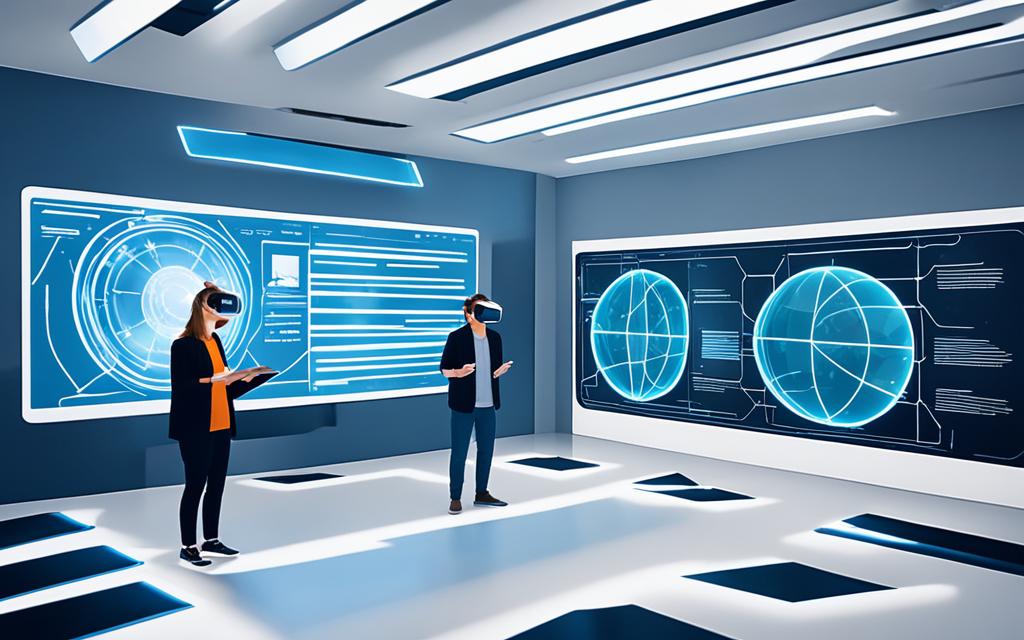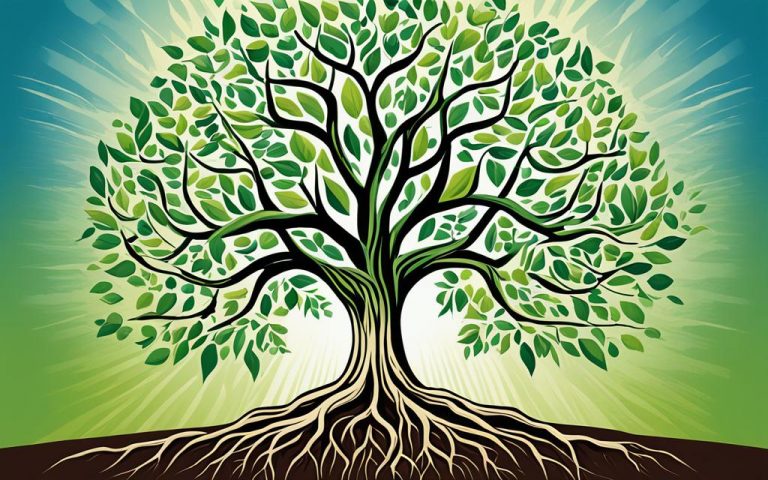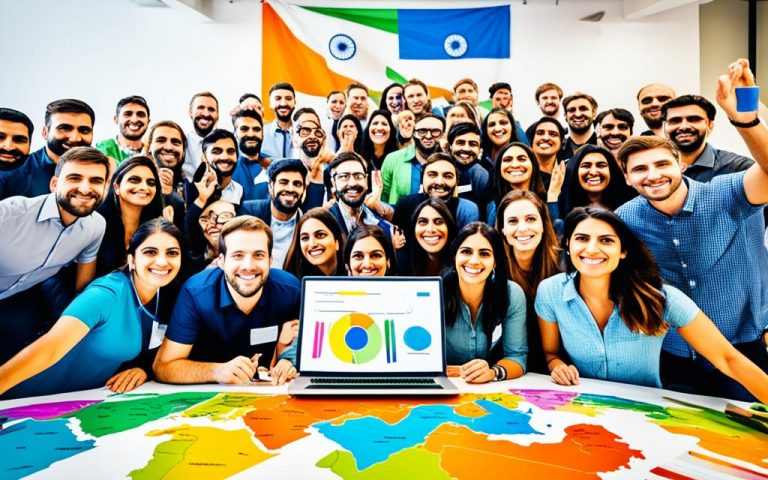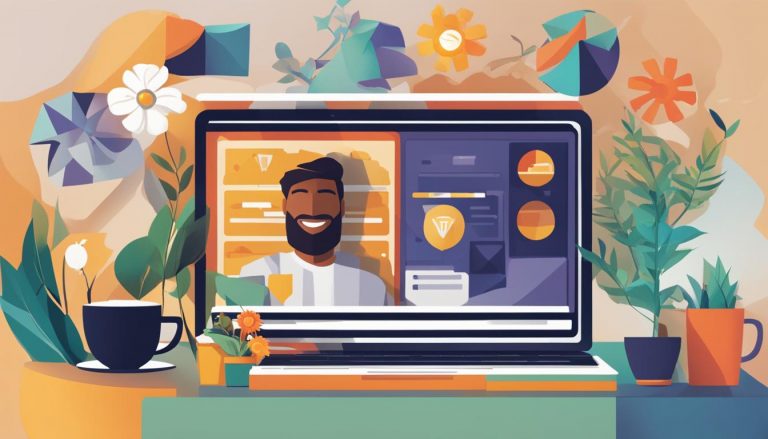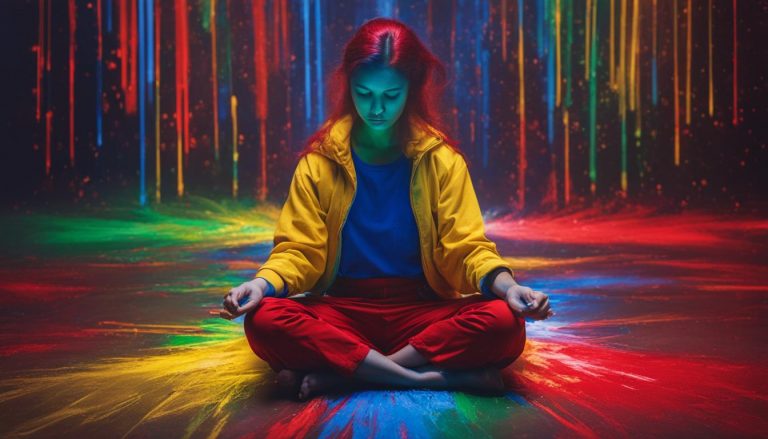Chat GPT’s Impact on Education: Revolutionizing Learning
The AI learning revolution is here, with ChatGPT leading the way. It uses the latest in language processing and algorithms. This tech makes learning come alive with tailored lessons for each student.
As AI gets better, ChatGPT is changing the face of education. It brings personalized help and fun lessons. This chatbot is shaping a new era in how we learn, making it more engaging and interactive for students.
Key Takeaways
- ChatGPT leverages AI to provide adaptive and interactive learning experiences.
- This technology offers personalized tutoring and support based on individual needs.
- ChatGPT facilitates immersive education through real-time feedback and multimedia content.
- AI-powered learning revolutionizes the way students interact with educational material.
- Integrating ChatGPT paves the way for the future of learning and curriculum development.
Harnessing the Power of AI for Personalized Tutoring
In the world of educational tech, AI like ChatGPT is leading the charge in personalized tutoring and adaptive learning paths. This new tech uses smart algorithms to check how each student learns. It then customizes the learning process based on what each student needs.
Adaptive Learning Paths for Individual Needs
AI tools excel at making learning journeys just for you. They keep a constant eye on how well you’re doing. If you need more help somewhere or if you’re ready for a challenge, they adjust what you’re learning to match.
Interactive Lessons with Real-Time Feedback
AI isn’t just smart, it’s engaging too. Interactive lessons bring a fun vibe to learning. ChatGPT talks back to you, breaking down topics and giving answers on the spot. This way, you learn actively and get the chance to really understand the lesson.
“The integration of AI into education is more than just a technological advancement; it’s a paradigm shift that empowers learners to take control of their educational journey.” – Dr. Sarah Thompson, Educational Technologist
The on-going marriage of AI and education holds a lot of hope. It aims to change how students learn and think critically, leading to better and fairer learning for everyone. It’s a promising path forward.
Enhancing Educational Accessibility and Inclusivity
ChatGPT makes education better by being more accessible and inclusive>. It uses smart tech to fight the digital divide. This helps students from all backgrounds enjoy top-notch learning materials.
Bridging the Digital Divide
The digital divide stops poor communities from using tech and online stuff. But, ChatGPT can change that. It’s a free, smart educational helper. This means students from poor families get personal tutoring and cool learning stuff, no matter how much money they have.
Accommodating Diverse Learning Styles
ChatGPT is great at handling diverse learning styles. It offers tons of ways to learn: you can read, listen, watch, or try things out. So, students who learn best in different ways all get what they need. This makes school a better place for everyone to succeed.
ChatGPT also talks like a real person, so it can help students in a way that works just for them. It doesn’t matter what you need, it’s here to help. This makes sure all students can keep up and get a good education.
By embracing AI like ChatGPT, our classrooms can be places where everyone’s welcome. It lets us cheer for our differences while helping every student do their best.
Thanks to ChatGPT, our schools are getting more open and fair. It helps all students, no matter where they come from or how they learn. With ChatGPT, everyone can learn well and succeed in school.
Revolutionizing the Learning Experience
AI technologies like ChatGPT are changing the way we learn. They make learning more fun and involved. With these tools, students can talk to ChatGPT like it’s a real tutor. They can ask anything, get clear answers, and dive into topics deeply. This way of learning helps students get more into what they are studying.
AI-Powered Educational Assistance
ChatGPT gives students their own personalized learning buddy. It uses AI to understand their unique way of learning. This buddy answers questions right away and explains things in a way that fits each student. It feels almost like having a personal tutor, improving how students learn.
Immersive and Engaging Learning Experiences
ChatGPT can also make learning truly exciting and immersive. By adding videos, simulations, and games, it catches student’s attention. They are not only fun but help students remember and understand better.
With ChatGPT, learning becomes an adventure full of cool images, moving simulations, and fun quizzes. This way, it suits all kinds of learners. Everyone gets to enjoy and understand even the most complex topics.
By mixing AI-powered help with exciting ways to learn, ChatGPT is changing education. It’s helping students succeed and love learning for life.
Fostering Creativity and Critical Thinking
In today’s world, advancing AI like ChatGPT makes fostering creativity and critical thinking key. ChatGPT not only shares knowledge but also challenges students. It pushes them to build problem-solving skills by thinking outside the box.
Encouraging Exploration and Curiosity
ChatGPT goes beyond providing answers. It encourages students to see different views and combine ideas from many places. This sparks curiosity and encourages deep dives into complex topics.
They start asking questions that spark new thoughts and insights. This process helps them not only in school but also in the real world.
By using ChatGPT, students learn to be creative. They also get ready to face tough challenges in the future. These include dealing with a lot of information and quick changes.
“Curiosity is the wick in the candle of learning.” – William Arthur Ward
Teachers who use ChatGPT help build a space for critical thinking and curiosity. This empowers students to think deeply, question things, and adapt to change. These are skills they need as they grow in a changing world.
Revolutionizing Classroom Dynamics
Integrating ChatGPT into classes is changing how students work together. This change is creating tech-fueled ways for them to learn collaboratively. It helps students work on projects, exchange ideas, and learn from each other. This improves teamwork and communication skills.
Technology-Enhanced Collaborative Learning
Picture a class where students use ChatGPT to solve hard problems and build knowledge together. This joint effort not only makes ideas clearer but also boosts skills like thinking critically and using tech well.
AI lets us build classes where everyone works together to understand topics deeply. This happens by bringing different views and experiences into the learning process.
Empowering Educators with Advanced Tools
ChatGPT isn’t just for students; it also helps teachers a lot. It gives them tools to better plan lessons, view real-time student progress, and find teaching resources easily. This tech saves time, letting teachers focus on teaching in better ways.
With ChatGPT, teachers can:
- See how students are doing right away and change their teaching as needed.
- Use detailed data to figure out what’s working and what needs to change.
- Find and use lots of teaching materials to make their lessons better.
This
teacher support
lets educators do what they do best: inspire and teach. It helps them share the joy of learning with their students.
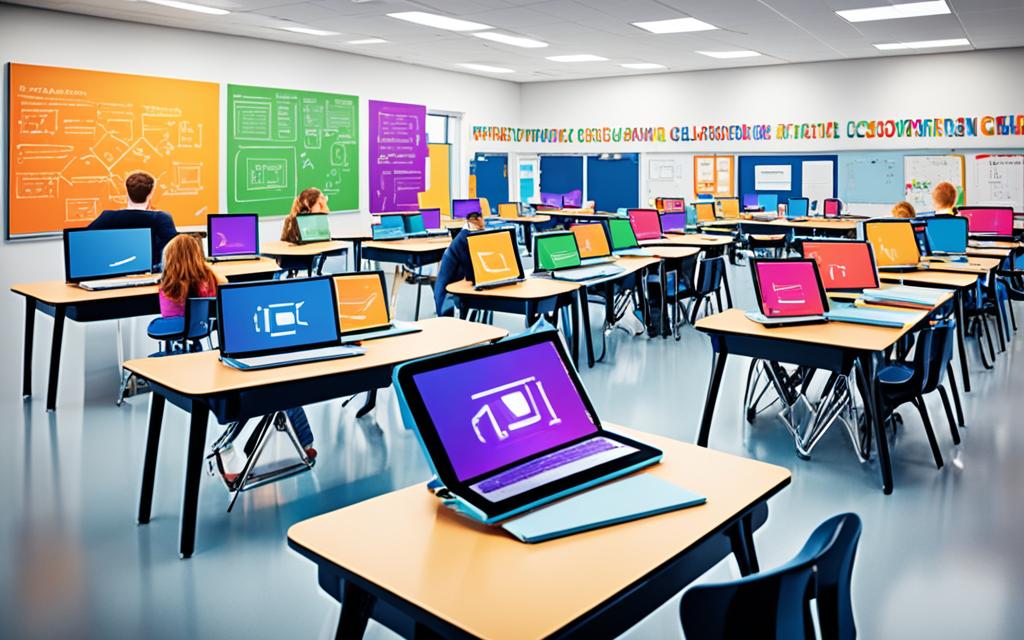
Adapting Curricula to the Future of Learning
In today’s fast-changing tech world, adapting curricula for the future of learning is important. Emerging technologies are changing how work is done. It’s crucial for students to learn future-ready skills to do well in the AI-driven workforce.
Integrating Emerging Technologies
Schools need to start using new tech, like ChatGPT, in their teaching. This will help students get to know the latest tools and learn more about AI.
Integrating emerging technologies teaches students how the new tools work. It lets them think about what AI can and cannot do.
Preparing Students for the AI-Driven Workforce
Learning these tools early helps students build important skills for AI jobs. They’ll get good at things like:
- Data analysis and interpretation
- Computational thinking and problem-solving
- Human-machine collaboration and communication
With AI changing many jobs, these skills are key for students’ success. They’ll be ready for the fast job market changes.
| Traditional Skills | AI-Driven Skills |
|---|---|
| Memorization | Critical Thinking |
| Routine Tasks | Problem-Solving |
| Siloed Knowledge | Interdisciplinary Collaboration |
Teaching future-ready skills helps schools prepare students for AI’s work life. This makes sure they are ready and able to do well in a job market that keeps changing.
Addressing Ethical Considerations and Challenges
As we use ChatGPT and AI in education, tackling ethical considerations and challenges is key. We must make privacy and data security a priority. This is because AI might gather and analyze personal student details without intention.
Ensuring Privacy and Data Security
Schools need to protect students’ data privacy and security. They should set solid data safety rules and follow the law. Using high-level encryption and controlling who can access the data is crucial.
Telling students and parents clearly about how their data is used helps build trust. It creates an open and responsible atmosphere around AI use in learning.
Mitigating Biases and Algorithmic Fairness
Dealing with algorithmic bias and ensuring fairness is critical. AI systems like ChatGPT must pass thorough tests and checks. This helps spot and fix any biases coming from the information it was taught on.
This approach makes sure AI doesn’t amplify existing prejudices in the education it offers. It aims for a fair and just learning environment for all students.
Schools, AI experts, and ethicists should work closely together. They should set up strong ethical frameworks and ensure transparency. This way, everyone will be accountable for the fair use of AI in education.
| Ethical Consideration | Potential Challenges | Mitigation Strategies |
|---|---|---|
| Data Privacy | Unauthorized access to sensitive student data | Encryption, access controls, data governance policies |
| Algorithmic Bias | Perpetuation of societal biases and discrimination | Algorithm audits, diverse training data, fairness metrics |
| Transparency | Lack of explainability in AI decision-making | Interpretable models, documentation, stakeholder engagement |
| Accountability | Unclear responsibility for AI-driven decisions | Ethical governance frameworks, oversight mechanisms |
The Evolving Role of Educators
AI-powered technologies like ChatGPT are changing the way teachers work. These new tools help teachers but cannot replace them. Educators need to change how they teach, focusing on working together with students more.
Redefining Pedagogical Approaches
In the AI age, educators need to help students develop important skills like thinking critically and solving problems. Teachers are now like guides, pushing students to think, question, and work with others in their learning.
Embracing Lifelong Learning
Staying current means teachers must always learn and grow themselves. This keeps them updated on new tech and helps them use AI tools to make learning better for their students.
“The role of the educator is not to transmit knowledge, but to facilitate learning.” – Albert Einstein
In today’s fast-changing world, teachers need to improve and find new ways to make students lifelong learners. With ongoing learning and updated teaching methods, they can use AI to inspire innovative and critical minds in their classrooms.
Unlocking Global Educational Opportunities
The use of ChatGPT and AI in education is opening up the world. It lets students and teachers from any part of the globe come together. Virtual classrooms and online learning remove boundaries, letting people share and learn from each other’s cultures.
Transcending Geographic Barriers
Now, where you live doesn’t limit your education. Online platforms offer learning chances to everyone, even in remote places. This equal chance means anyone can follow their dreams in education, no matter where they are.
Fostering Cross-Cultural Exchange
AI connects people from different cultures. It helps them share ideas, fostering better understanding. Experiencing global viewpoints makes learning more enriched and promotes empathy. It readies students for a world where connections matter more than ever.
As Malala Yousafzai, the renowned advocate for girls’ education, said, “Let us pick up our books and our pens. They are our most powerful weapons.”
AI also helps in making new curricula and carrying out meaningful research. It tackles worldwide issues and brings understanding across cultures, all thanks to smart platforms.
| Traditional Education | AI-Powered Global Education |
|---|---|
| Limited by geographic boundaries | Transcends geographic barriers |
| Restricted access to diverse perspectives | Facilitates cross-cultural exchange |
| Localized curricula and resources | Sharing of global knowledge and best practices |
| Isolated academic communities | International collaboration and partnerships |
The table up there points out how AI changes the game in global education. It highlights the power of these tools to make education truly worldwide.
Conclusion
As AI technologies like ChatGPT become more common in education, we are on the verge of a big change in the future of education. These new tools can bring personalized teaching, engaging lessons, and flexible learning designed for each person. But, we must be careful with this AI integration. We need to be responsible and tackle the challenges that new tech brings.
The shift to AI-enhanced learning calls for teamwork. Educators, researchers, and tech makers must work together. By always looking to get better and being open to change, we can use the best of these new tools. This way, we keep things ethical. We also ensure that AI helps everyone learn, connects the world, and builds skills for the AI-driven world.
Navigating this new path is key. It’s all about using technology rightly, without forgetting our morals. We want the future of education to inspire students, help them grow, and get them ready for life in an AI-driven world. Yes, it’s a big mission. But, the chance to change how we learn and discover more is exciting.
FAQ – Chat GPT’s Impact on Education: Revolutionizing Learning
How can ChatGPT provide personalized tutoring?
ChatGPT looks at what a student knows and doesn’t know. It then tailors learning to fit them. This means offering lessons that mesh with how each student learns best. It’s like having a digital tutor who customizes its teachings just for you.
How does ChatGPT enhance educational accessibility and inclusivity?
ChatGPT helps make learning available to all, no matter their background. It brings top-notch learning to students across the economic spectrum. By using various teaching methods, it ensures every student feels welcomed and included.
How can ChatGPT revolutionize the learning experience?
ChatGPT is more than a chatbot; it’s a learning companion. It talks with you, answers questions, and explains things deeply. It makes learning fun with videos, simulation games, and interactive activities.
How does ChatGPT foster creativity and critical thinking?
ChatGPT urges students to explore beyond the obvious. It helps them solve problems, think critically, and come up with new ideas. By encouraging wider thinking, it boosts creativity and sharpens analytical skills.
How can ChatGPT revolutionize classroom dynamics?
ChatGPT turns classrooms into creative teamwork hubs. Students can team up, swap ideas, and learn from each other. For teachers, it offers high-tech help like analyzing lessons, planning personalized teaching, and finding lots of knowledge online.
How can ChatGPT help adapt curricula to the future of learning?
By adding ChatGPT to lessons, schools can prep students for tech-heavy jobs. It teaches skills like working with data and teaming up with machines. This helps them get ready for the future job market.
What are the ethical considerations and challenges associated with using ChatGPT in education?
Keeping kids’ and teachers’ data safe is a big concern. So is making sure the tech is fair and not biased. Schools need strong rules and habits to use AI tech in a fair and safe way.
How will the role of educators evolve with the integration of ChatGPT?
Teachers will become more like learning guides. They’ll help kids think deeper, solve problems, and work well in teams. And they’ll learn new teaching tricks to keep up with the changes in how we learn.
How can ChatGPT unlock global educational opportunities?
ChatGPT makes learning together easy, no matter where in the world we are. It links students and teachers globally through virtual classes and online learning spots. This mixes different cultures, ideas, and learning ways, pushing forward new creative learning and research.

